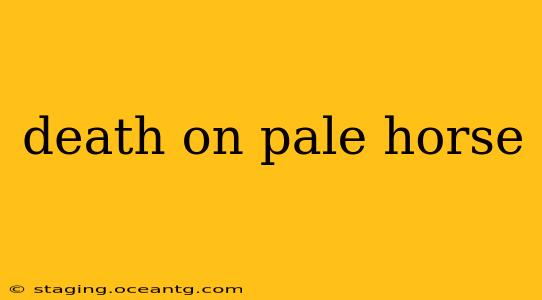Death on a Pale Horse: Unraveling Agatha Christie's Masterpiece
Agatha Christie's Death on the Pale Horse, published in 1961, stands as a chilling exploration of murder, intrigue, and the shadowy world of occult practices. Unlike some of her other novels focused on a contained setting, this story unfolds across diverse locations, showcasing Christie's mastery of suspense and her ability to weave together seemingly disparate threads into a terrifying whole. This deep dive will explore the novel's key elements, addressing common questions surrounding its plot and characters.
What is the mystery in Death on the Pale Horse?
The central mystery revolves around a list of names found in the possession of a dying man, Ariadne Oliver's friend. This list connects several seemingly unconnected individuals to a sinister organization involved in contract killings. Mark Easterbrook, a seemingly ordinary insurance investigator, becomes embroiled in this dangerous game when he stumbles upon the list. He must unravel the organization's complex web of deceit, facing constant threats and unexpected twists as he gets closer to the truth. The mystery is less about who committed the murders (though that is part of it) and more about how this organization operates and the chilling implications of its existence.
Who is the murderer in Death on the Pale Horse?
While the novel features multiple deaths, the true mastermind behind the organization and the primary perpetrator remains shrouded in mystery until the very end. Christie expertly constructs the suspense, offering potential suspects and red herrings throughout the narrative. The reveal is both shocking and satisfying, highlighting the author’s ability to maintain tension and keep the reader guessing. The identity of the murderer is intrinsically linked to the organization itself, making the resolution more impactful and thought-provoking than a simple “whodunit.”
What is the significance of the pale horse?
The pale horse, a direct reference to the Book of Revelation, represents death and destruction. Its inclusion in the title and throughout the narrative serves as a symbolic representation of the sinister organization and its deadly activities. The organization uses seemingly legitimate businesses as a cover for its nefarious operations, suggesting a hidden, powerful force operating beneath the surface of everyday life. The imagery of the pale horse adds a layer of unease and reinforces the novel's themes of hidden evil and impending doom.
Is Death on the Pale Horse considered one of Agatha Christie's best works?
While opinions on Christie's best work are subjective and vary widely among readers, Death on the Pale Horse is frequently cited as one of her most ambitious and chilling novels. The darker tone, complex plot, and exploration of occult themes set it apart from some of her more traditional whodunits. Many critics and fans praise the novel for its suspenseful pacing, well-developed characters, and the unsettling atmosphere it creates. Its unique blend of mystery, suspense, and a touch of the supernatural solidifies its place among Christie's significant contributions to the genre.
What is the role of the occult in Death on the Pale Horse?
The occult plays a significant role, framing the organization's activities and adding an extra layer of intrigue and darkness to the plot. It’s not merely a superficial element; it's woven deeply into the story's fabric, influencing the actions and motivations of various characters. The use of seemingly supernatural elements adds to the unsettling atmosphere and contributes to the novel's overall chilling effect. Christie masterfully blends the supernatural with the real, making it difficult to discern where one ends and the other begins.
How does Death on the Pale Horse differ from other Agatha Christie novels?
Unlike many of her cozy mysteries, Death on the Pale Horse delves into darker and more sinister themes. The investigation is significantly more dangerous and complex, pushing the boundaries of a traditional detective story. The use of occult elements and the exploration of organized crime differentiate this novel, making it a more mature and unsettling read compared to some of her lighter works. The novel's scope is broader, moving beyond a confined setting to incorporate various locations and a wider range of characters.
In conclusion, Death on the Pale Horse remains a compelling and unsettling read, showcasing Agatha Christie’s unparalleled ability to craft suspense and explore darker aspects of human nature. Its complex plot, chilling themes, and memorable characters ensure its enduring appeal to mystery lovers worldwide. The novel’s lasting power lies not only in solving the mystery but also in the unsettling questions it raises about the darkness lurking beneath the surface of seemingly ordinary lives.
